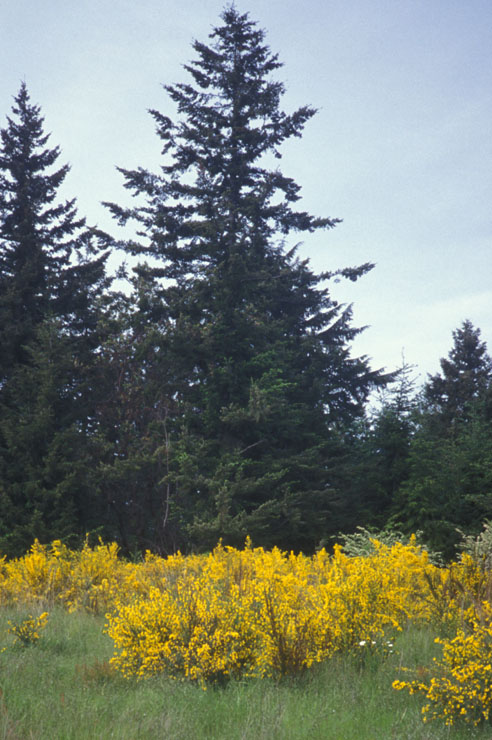
|
| Scotch Broom; Cytisus scoparius (L.) Link |
Pea Family; LEGUMINOSÆ (FABACEÆ)
|
| Scotch Broom is a very common big bushy weed. Some people will object to calling it a weed. Some people think the moon is
made of cheese. Scotch Broom is weedy even though ordinary vegetable-gardeners may not think so. |
| From Western Europe originally, it is the best known of various kinds of Brooms, named because useful sweeping brooms are
easily made from the twiggy brush. Why it is called Scotch or Scot's Broom is a mystery, though it is also called Common Broom or Broom, period. The scientific name Cytisus is adapted from an ancient Greek name; the Latin specific name
scoparius means broom-like. |
| Introduced to the Pacific Northwest by Captain Colquhoun Grant of Sooke, Vancouver Island, around 1850, Scotch Broom
quickly invaded coastlines, meadows, roadsides, clearcuts and other open sunny areas. Because of its wanton reproduction, forming
sometimes choking colonies, it has long been considered too much of a good thing. |
| It has wiry, grooved evergreen twigs, but also tiny clover-like leaves in summer, especially prominent on the young plants only a
foot or two tall. The slender twiggy branches are tough to break, flexible and strike me as quite the thing for broom-making. Probably they
should be gathered for this purpose during fall or winter. |
| Though sporadic flowers can be seen
every month (even December and January) the main explosion of yellow is from late April
into May and June, when it erupts into scented bright yellow or red-spotted blossoms, of piercing drama. Everybody knows it then.
Allergy-sufferers curse its pollen. Bees joyfully court it. In August the flat seedpods, an inch or two long, hairy on the edge, and very dark,
have dried enough to explode with popping noises, thereby making meadows lively with sound. |
| The flowers are so unstinting and pretty that garden versions and hybrids such as 'Moonlight' are planted in masses along
freeways and in other barren, ugly sites. For most Brooms tolerate with easy nonchalance baking sunny sites and poor soil. Severe wintry blasts
alone sometimes kill them back. But nobody pities the Broom. We know darn well how it returns with strength unabated in spring. Cast-iron
weeds they are, or admirable, tough garden plants, according to how many we have. |
| A great plus is Broom's ability to fix nitrogen through root-nodule symbiosis. Meaning, unlike most plants, which grow poorly in
soils low in nitrogen, Broom thrives by simply making its
own nitrogen even as porcupines make their own armor of needles. Uproot a
Broom and you can see plainly little roundish swellings: these do the trick. Most members of the pea family
(leguminosæ), besides a few other plants such as alders, can do this. The result is a richer soil every year. |
| It is a short-lived plant, quickly reaching about 6 to 12 feet tall, then dying and presenting a scrawny, scratchy mass of tinder:
dangerous fuel for brush fires. Though the fresh green plant is easily sliced or cut, the dry dead wood is hard, brittle and incendiary. A
spiny broom called Gorse, Furze or Whin is
Ulex europæus, neither as common or well known, but also a weedy yellow-blossomed introduced
shrub. Dyer's Broom, Genista tinctoria, is still another yellow-flowered wild bushy weed, of even less consequence. |
| In bygone times the flowerbuds were pickled as caper substitutes by some folks. A tea of the plant was used to combat gallstones,
and other therapeutic uses prescribed. Some people brewed a coffee from the roasted seeds. California Quail are said to eat the seeds.
However, since the plant contains toxic alkaloids it should be considered poisonous. |
| In the Language of Flowers, Broom signifies variously: mirth, neatness or humility. The
neatness is obvious for a broom-plant. The
mirth is a joke beyond my understanding; the
humility may initially seem at odds with such a conquering globetrotter, but must
have reference to its being used to sweep dust. |
So Scotch Broom cannot be condemned as altogether vile: it improves soil, is a good erosion-control plant, is pretty, is tough,
supplies broom-material, and pleases bees. Florists can use it somewhat, too. On the other hand, it is a
too-abundant plant, fire hazard, and toxic to livestock.
|
Originally published as the Seattle Tilth newsletter Weed of the Month in February 1991, along with an illustration from a book.
Back |
|
|

